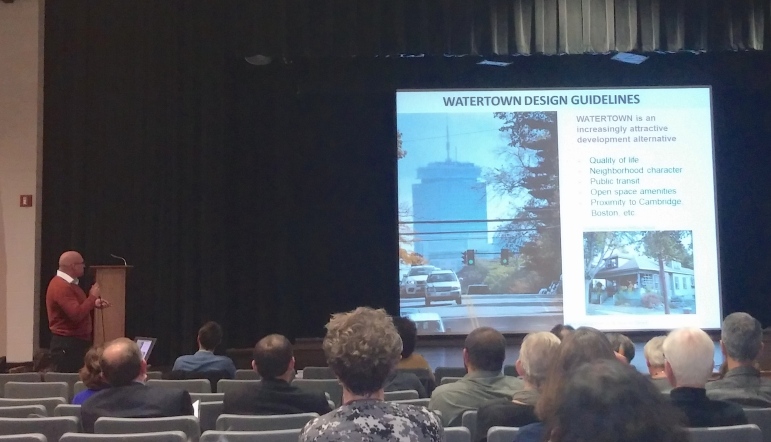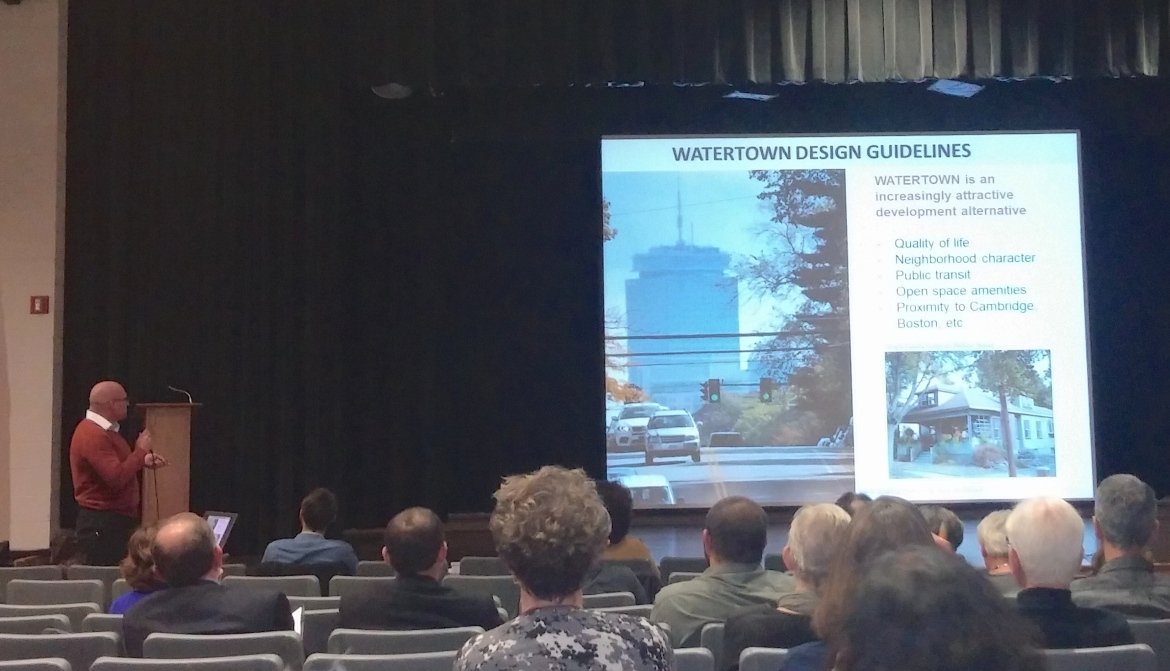
Design consultant David Gamble, left, discusses the design standards and guidelines being created in Watertown.
More than 100 people showed up Wednesday night to find out about Watertown’s new design standards and give input about what they hope to get from them.
Design standards and guidelines provide a visual and detailed explanation for how town zoning rules will work. The Town Council approved hiring David Gamble of Gamble Associates to create the new set of standards.
During the meeting at Watertown Middle School – Gamble, who is also a Watertown resident – explained what design standards and guidelines can do and what they cannot do.
They can:
- Improve the character of new developments
- Articulate standards of quality
- Provide Examples
- Represent spatial and dimensional criteria graphically
Gamble also warned they can also go too far, and make all new buildings look the same or be too restrictive.
What they can’t do is:
- Regulate building use
- Replace zoning or building codes
- Redesign streets and public rights-of-way
- Masterplan areas of the town
The design guidelines and guidelines will apply to commercial buildings large and small, and large residential projects, said Director of Community Development and Planning Steve Magoon.
One area Gamble wants to focus on is the intersection between the public and private realms – or how the sidewalks work with buildings in town. He showed some examples of how Minneapolis, San Antonio and Brookline demonstrate the design standards visually. Some had 3-D renderings.
Gamble polled attendees about some of the issues that they are concerned with, and how they hope the standards and guidelines will work.
For more than one-third of attendees, the biggest concern about how the town’s current zoning works was a lack of vision, followed by the quality of public/private realm and then scale. The amount of development was the biggest concern for under 15 percent.
When considering the most important character of town, most people – about half – said the integration of retail and commercial growth into the town. About a quarter answered congestion, under 20 percent said preserve open space and just over 10 percent said enhance commercial centers.
About a quarter of respondents voted that the most pressing issues were the traffic, scale of buildings, and design quality, followed closely by the environment. Location got just over 5 percent.
When asked what is most important to get right, more than 40 percent voted for design quality, and a quarter chose site plan (which includes circulation and parking). Building height and mix of uses got 15 percent each.
The audience was also asked what results they expect the design standards to get. Over half said they would raise the quality of development, a quarter said provide direction for development and just over 10 percent said remove ambiguity in the zoning. Seven percent said it would have little or no impact.
When asked why, one resident said she believed that many of the big parcels in town have already been redeveloped, so the town “missed the opportunity” for the new standards will not impact them.
Gamble said guidelines will not fix designs of prior projects, but can make sure they don’t happen again.
“They can say you can’t do a 250 foot wall, and that it needs multiple doors,” Gamble said. “They can also say the scale needs to be relative to the surroundings.”
The aim is to have the design guidelines and standards finished and published by early in 2015. Another meeting will be held before Thanksgiving, Gamble said.
Residents and others can send comments to Community Development and Planning Director Steve Magoon at smagoon@watertown-ma.gov.
